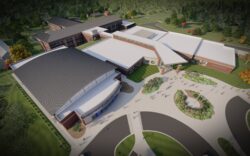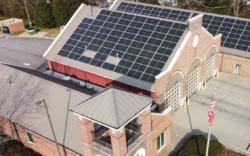When it’s finished, the Episcopal House on South Lumpkin Street will offer 104 students a place to live and worship together. And it will be one of the few private student residential facilities—other than Greek houses—adjacent to campus not owned by the University of Georgia.
Plans show a postmodern, multi-story, multi-purpose contemporary building rimmed by retail and bordered by lush landscaping. The interior will have expanses of natural light, natural ventilation, landscaping and open interiors. A chapel will be the focal point of the street-level view, “a welcoming space with a lot of light,” says architect Brett Nave, whose Athens firm, Studio BNA Architects, is designing the development.
The project is on the Athens-Clarke County Planning Commission’s Thursday, Feb. 2 agenda and will likely go before the Mayor and Commission for final approval in May, says ACC planner Rick Cowick. The Episcopal Diocese of Atlanta, which owns the property, wants a zoning change from commercial-office to commercial-neighborhood, planned development. The change will allow for more of the lot to be developed, giving students more community space, says Nave.
Since 2014, university representatives say they have met twice with the Episcopal Archdiocese to talk about the diocese’s interest in redeveloping the property, but they haven’t discussed specific plans. According to UGA spokesman Gregory Trevor, the university hasn’t made a formal offer to acquire the property.
In addition to student bedrooms, the plans show multi-level parking, common rooms, two commercial kitchens and large dining areas, each capable of accommodating a large group of people in different seating arrangements. Shared spaces will help foster a sense of community, officials say. The price tag for residents will be competitive with local market costs.
“This isn’t a business venture, it’s a mission,” says the Rev. Lang Lowrey, a staff member with the Atlanta diocese. “We are focused on building up a community for those who are looking for a home away from home.” One emphasis for the diocese is campus ministries, for Emory and Georgia State as well as UGA. On the diocese-owned land here is the current St. Mary’s Chapel, built in the 1970s. An adjacent building, a house donated decades ago as a student center, has already been demolished.
“What we’re creating is an intentional living community, with the emphasis on community,” Lowrey says. “With retail on the ground floor, we’re looking at something that can be sustainable. There are lots of common spaces for interactions, fellowship and studying.”
In a Nov. 16 letter to the ACC Planning Department, UGA officials cited several concerns about the project, including continuing to give access to the building via state-owned University Court, the street that snakes around Oglethorpe House and runs from Lumpkin to Cloverhurst Street. “Any redevelopment that would negatively impact the safety of our students or the burden and cost to the university would result in a retraction of the courtesy,” the letter says. The plans show access to the project via Lumpkin Street.
UGA Vice President for Governmental Affairs Griff Doyle and Vice President for Finance and Administration Ryan Nesbitt, who signed the letter, want the project to be in compliance with local zoning laws, and it is. Cowick says the local government is “looking at the floor plans very closely to make sure it’s a true dormitory, with just beds, not individual dwellings.” The Episcopal House design addresses UGA’s concern by providing only beds in individual rooms, with no kitchens.
According to UGA officials, “the design of the proposed redevelopment must be consistent with the character of the neighborhood.” The term “neighborhood” isn’t defined in the letter, but nearby buildings include the Lutheran Chapel, Oglethorpe House and its dining hall, the multi-story Lyons apartment complex and a small commercial strip, Boggs Hall and, across Lumpkin, the red brick Myers residential complex.
Lowrey believes the new Episcopal House will attract serious students interested in enjoying fellowship and being with like-minded classmates, as has happened at Episcopal facilities in other states. “We’ve done similar projects across the country, and it’s worked well,” he says. “The diocese and our national church are both very excited about this project in Athens.”
Like what you just read? Support Flagpole by making a donation today. Every dollar you give helps fund our ongoing mission to provide Athens with quality, independent journalism.










